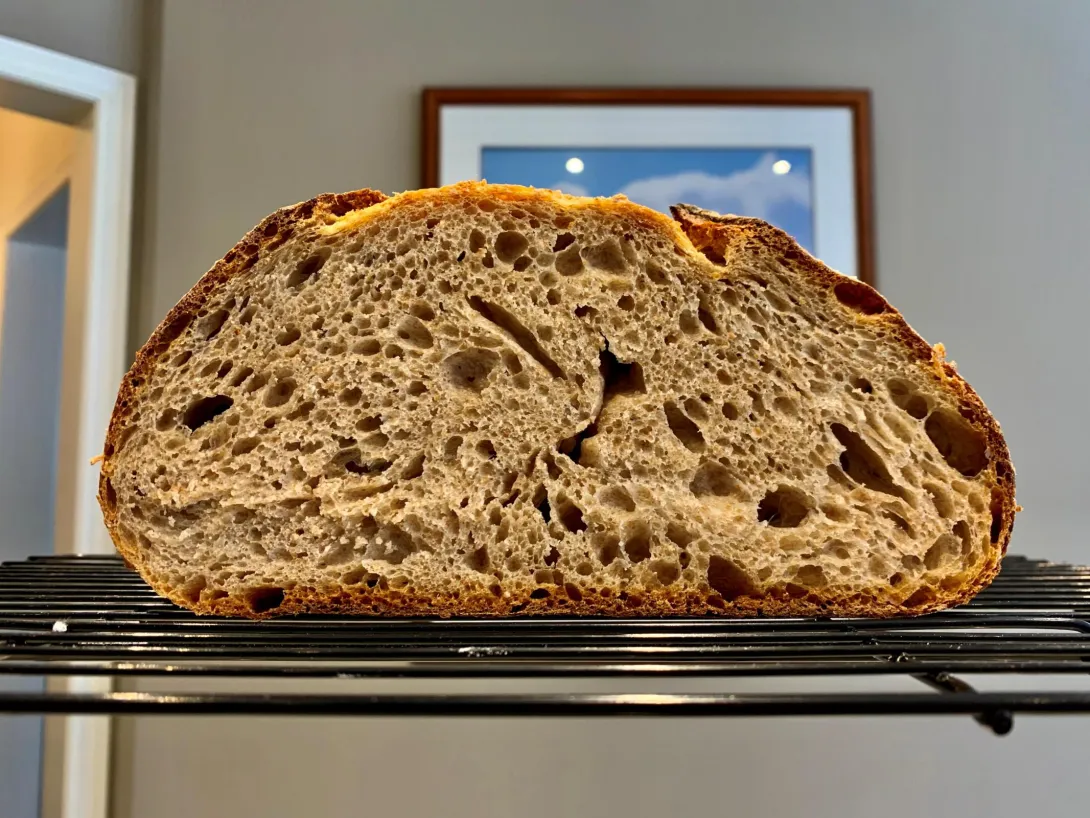
I had a limited time to bake this bread so I utilized my oven as a proofing box.

150 gr A/P flour, 100% hydration starter
238 gr A/P flour
203 gr whole wheat flour
10 gr salt
290 gr lukewarm water
1. Mix well flours and salt
2. In a separate bowl, mix well water and starter
3. Combine flour mix and water mix. Work the dough until all the flour is wet.
4. Start bulk fermentation: put the dough in a covered bowl inside an oven and turn on the light. The temperature should stabilize about 82F (28C) degrees. If it goes higher - turn off the light.
5. Bulk fermentation should take about 3 to 4 hours and the dough should rise about 1.5 to 2 times in volume and still be a bit hard to the touch. During the first 2 hours, do the followings 2 or 3 times: make a four sides fold, round the dough inside the bowl and put it back in the oven.
6. At the end of bulk fermentation, fold the dough once more and put it on the work surface. Round the dough and let it rest covered for 20 minutes.
7. Shape into a round, put the dough in a Benetton and put covered in the oven to proof. An example arrangement is shown in the photos below
8. I proof until the dough almost overflows the Benetton, I don’t poke at the dough to test. That should take about two hours.
9. Score and bake - 20 minutes covered @ 480F, 20 minutes uncovered @ 450F


Nice looking loaf of bread, well done.
Nice crumb, nice oven spring, great looking 40% whole wheat loaf.
Benny
Where is the dough while the stone is heating up?
I keep a cool house and proof in my oven too, but gave up on baking stones because taking a fully risen loaf out of the oven long enough for the stone to heat didn’t go well. So my regular baking is pan loaves, which do well starting in a cold oven. But that’s a lovely loaf, I’m very curious!
This arrangement is just for the fermentation and not for baking. I just use the bowl and the baking stone to seal the humidity for the dough. when fermentation is done, I start heating the oven and keep the dough covered on the countertop. Maybe you need to ferment a little less. I am preparing another post that might interest you regarding fermentation.
I've been really challenged to get the a good rise and nice air pockets like you do, from my loafs with some whole wheat or all whole wheat recipes. Does using AP flour work best to get your results instead of higher protein bread flour?
Hi Mr. C. , I am not sure if you are referring to this particular recipe or in general. In my opinion, the single, most important factor in getting good bread results is repetition. This recipe, with different variations, is my daily bread – I make it about five times a week. I can glance at the starter and know if it is in good shape. I look at the dough, and I know if bulk and proofing are ready to go. So I became an expert in this particular dough and as a result, I manage to repeatedly bake fantastic bread. I can switch A/P with bread flour and there is almost no difference, because, I probably adjust time without even thinking about it. Therefore, my first advise is to pick one recipe that you like and repeat doing it many times until you find what works really well. From there – it is easy to make variations to the flours and add nuts and fruits while keeping the same baking concept that works for you. My second advise is to try proofing for a longer time. Dough does not over proof so quickly and the longer you wait the more gas is captured in the dough. Try also bulking and proofing at 28C (inside an oven with the light on) instead of room temperature. At this temperature the yeast is most active and produces more gas.
You can take a look at my observations here: http://www.thefreshloaf.com/node/62309/about-open-crumb
And one variation of the same dough: http://www.thefreshloaf.com/node/62360/apple-pecan-sourdough